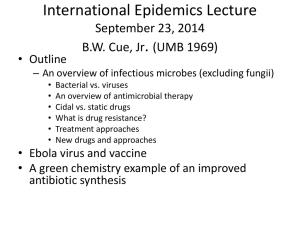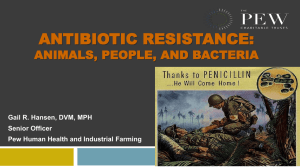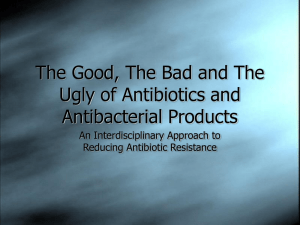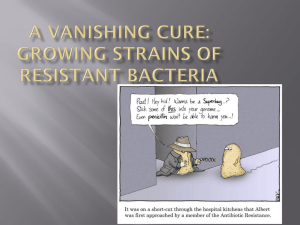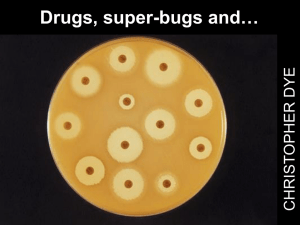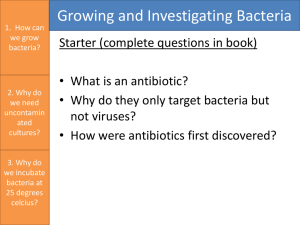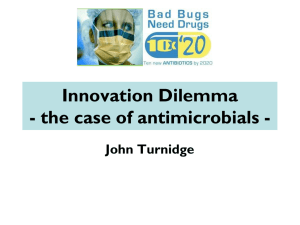hauger(2) - Texas Department of State Health Services
advertisement
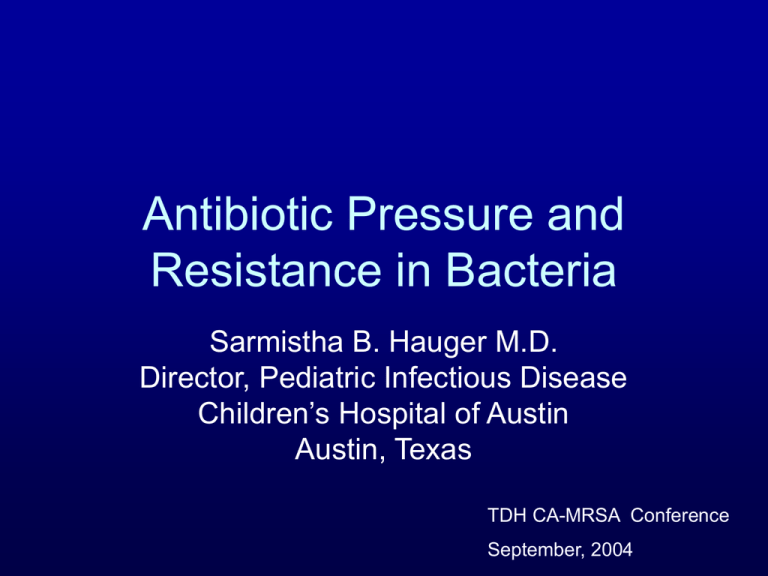
Antibiotic Pressure and Resistance in Bacteria Sarmistha B. Hauger M.D. Director, Pediatric Infectious Disease Children’s Hospital of Austin Austin, Texas TDH CA-MRSA Conference September, 2004 Antibiotic Pressure and Resistance in Bacteria • • • • What is it and why is it important? How extensive is it? How does it happen? What factors promote the spread of resistant bacteria ? • How does it pertain to the development of CA-MRSA infections? • What can HCW do to curb this trend? Antibiotic Pressure and Resistance in Bacteria What is it ? • ”Selection pressure of antibiotics has led to the emergence of antibiotic-resistant bacteria.” – Antibiotics can effect bacteria unrelated to the targeted infectious agent; these may be “normal” flora, leading to the emergence of resistant mutants inhabiting the same environment. Baquero et al., International Report 1996;23:819 Antibiotic Pressure and Resistance in Bacteria Why is it important? • Antibiotic resistance has developed in almost all classes of bacteria of pathogenic potential. • Resistance in organisms of low virulence can emerge as important pathogens. • The development of resistant bacteria has driven pharmaceutical research to develop more potent, broad-spectrum antibiotics. • Use of these in turn, has fueled the appearance of bacteria with newer modes of resistance. Antibiotic Pressure and Resistance in Bacteria Why is it important? • Infections with resistant bacteria occur in health care settings AND the community. • Examples of hospital setting: MDR Gram neg, MRSA, VRE • Examples of community : MRSA, PRSP, Pcn R Quin R N. gonorrhea, antibiotic resistant Salmonella and Shigella Emergence of Antibiotic-Resistant Bacteria S aureus Gram-negative rods N. gonorrhoeae P e n i c i l l i n A m p i c i l l i n H. influenzae M. catarrhalis S. pneumoniae Enterococcus sp. 1950 1960 Cohen; Science 1992;257:1050 1970 1980 3rd gen Cephalosporins 1990 Quinolones How extensive is the problem ? Percentage of Laboratory Isolates Resistant to Antibiotics, Texas 35 30 25 20 15 10 5 0 1999 2000 2001 Vancomycinresistant Enterococcus Species Penicillinresistant Streptococcus pneumoniae Scope of Problem: S. pneumoniae • Most common cause of bactemia, bacterial pneumonia, meningitis, OM, sinusitis in childhood. • Highest rates of invasive pneumococcal disease occur among young children, especially those aged <2 years • US data: the seven most common serotypes isolated from the blood or CSF of children age <6 years account for 80% of disease • Antimicrobial resistance is detected most frequently among these same serotypes. • 1998 surveillance data from eight states: these serotypes accounted for 80% of penicillin-nonsusceptible isolates. Percentage of Invasive Pneumococcal Isolates Nonsusceptible to Penicillin, Selected States,1997 40 843 439 35 30 25 Resistant 435 178 20 557 603 Intermediate susceptibility 182 15 10 5 0 MD CA OR CDC, MMWR 1999; 48(30):656-661 CT MN GA TN Mechanisms of Bacterial Resistance : how DO they do it ?? Antibiotic Pressure and Resistance in Bacteria How does it occur? • All antibiotics do NOT kill bacteria in the same way. • Various classes of antibiotics work on different aspects of bacterial replication. DNA gyrase Quinolones Cell wall synthesis DNA-directed RNA polymerase Rifampin ß-lactams & Glycopeptides (Vancomycin) DNA THFA Trimethoprim mRNA Ribosomes Folic acid synthesis DHFA 50 30 50 30 50 30 Protein synthesis inhibition Macrolides & Lincomycins Sulfonamides PABA Protein synthesis mistranslation Aminoglycosides Cohen. Science 1992; 257:1064 Protein synthesis inhibition Tetracyclines Antibiotic Pressure and Resistance in Bacteria How does it happen ? • Bacteria can become resistant as a result of genetic mutations; these can be transferred between bacteria and groups of bacteria. • Under selective pressure of antibiotic exposure, these strains then proliferate. Antibiotic Pressure and Resistance in Bacteria What happened to S. aureus ? • Can become Resistant to the B-lactam drugs (PCNs, Cephalosporins) by making a Blactamase. • In response to development of a drug that is stable to this mechanism (methicillin/oxacillin), S. aureus alters its binding site (PBP): Methicillin Resistant S. aureus (MRSA) • In response to use of other types of antibx to combat MRSA: few strains now with decr. sens to vancomycin, clindamycin. Antibiotic Pressure and Resistance in Bacteria What happened to S. aureus ? • Reports of increasing use of third gen cephalosporins and quinolones related to emergence of MRSA. • Some data suggest that quinolones enhance expression of methicillin reistance in SA in vitro • Outbreaks of MRSA have been reduced by curbing antibiotic use: esp cephalosporins Antibiotic Pressure and Resistance in Bacteria What factors promote their development and spread ? Alteration of normal flora Practices contributing to misuse of antibiotics Settings that foster drug resistance Failure to follow infection control principles Practices Contributing to Misuse of Antibiotics Inappropriate specimen selection and collection Inappropriate clinical tests Failure to use stains/smears Failure to use cultures and susceptibility tests Practices Contributing to Misuse of Antibiotics Inappropriate specimen selection and collection Inappropriate clinical tests Failure to use stains/smears Failure to use cultures and susceptibility tests Inappropriate Antibiotic Use Use of antibiotics with no clinical indication (eg, for viral infections) Use of broad spectrum antibiotics when not indicated Inappropriate choice of empiric antibiotics Inappropriate Drug Regimen Inappropriate dose - ineffective concentration of antibiotics at site of infection Inappropriate route - ineffective concentration of antibiotics at site of infection Inappropriate duration Settings that Foster Drug Resistance Community Day-care centers Long term care facilities Homeless shelters Jails Settings that Foster Drug Resistance Hospital Intensive care units Oncology units Dialysis units Rehab units Transplant units Burn units Physicians Can Impact Patients Other clinicians Optimize patient evaluation Adopt judicious antibiotic prescribing practices Immunize patients Optimize consultations with other clinicians Use infection control measures Educate others about judicious use of antibiotics Controlling Pneumococcal ResistanceIceland % nonsusceptible S. pneumoniae Public campaign, physician education, and increased antibiotic cost 25 20 15 10 5 0 89 90 Stephenson, JAMA 1996;275:175 91 92 93 94 95 96 Controlling Erythromycin Resistance in Group A Streptococci - Finland Erythromycin resistance Erythromycin consumption Erythromycin resistance (%) 4 30 25 3 20 2 15 1 10 0 87 88 89 Seppala, NEJM 1997;337:441 90 91 92 Year 93 94 95 96 5 Antibiotic Pressure and Resistance in Bacteria: Conclusions • Bacteria evolve resistance to antibiotics in response to environmental pressure exerted by the use of antibiotics. • Many of these bacteria are significant pathogens. • Our responsibility to our community is to use antibiotics prudently, for appropriate indications.

